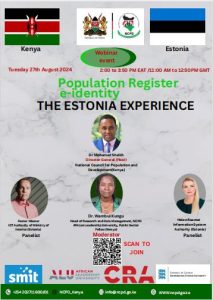KENYA AND ESTONIA EXPOLRE MODALITIES FOR MANAGING POPULATION REGISTER AND e-IDENTITY
KENYA AND ESTONIA EXPOLRE MODALITIES FOR MANAGING POPULATION REGISTER AND e-IDENTITY
In a landmark event, the Kenyan and Estonian governments shared experiences and best practices for managing a population register and e-identity on 27th August 2024.
The online conference dubbed “The Estonia Experience” was organized by NCPD, together with the Africa Leadership University (ALU) Centre for Reimagined Africa (CRA)and Estonian Government agencies; IT and Development Centre at the Estonian Ministry of Interior (SMIT) and Information System Authority (RIA).
NCPD developed a partnership with ALU / CRA in 2023, which has seen a staff from the Council sponsored for the African Leadership University Public Sector Fellowship Training in Tallinn, Estonia
The webinar event was moderated by Dr. Wambui Kungu, Head of Research & Data Management, NCPD, while in the panel were Peeter Maeker – ICT, and Helen Raamat (RIA) from Estonia.
The webinar provided a platform for sharing innovative and best practices on the implementation of the population register and e-ID, emerging trends and challenges related to population dynamics and development, what Estonia has achieved, and what Kenya and other African countries can learn from Estonia’s experience.

The Population register in Estonia has been in existence since 2002, and is entrenched under the Population Register Act.
The main stakeholders in the Estonian eID ecosystem are;
- Ministry of Interior which is in charge of the issuance of identity documents
- The Ministry of Justice is responsible for the quality and safety of eID services
- Private who include different stakeholders e.g mobile network operators, banks and e-service providers, certification authority, and card manufacturers
Apart from the Estonian citizens, the other groups whose data is in the population register are;
- EU citizens who have living rights in Estonia
- Persons who need an identification code
- Citizens from third countries, who have living permits
- Persons in archives
The panelists informed the participants that 99% of the services in Estonia are online and that the same percentage of the population has eIDs.
Right from birth a newborn baby is legible for an eID, instead of a birth certificate
All services are accessed by use of eID
The authenticity of the eID is the signature that has replaced the use of rubberstamps
This Estonian eID can be used as a pass to all EU countries
The population registers are important as an independent source of demographic statistics such as current population estimates, vital and migration statistics and are an alternative to population censuses. EID offers convenience and efficiency to both citizens and governments.
As Kenya and other African governments move towards digitizing government services, e-ID and Population registers are key. We need to learn from those who have walked the journey and succeeded.

